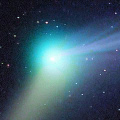
|
Now it is 6.4 mag (Jan. 30, Danil Sidorko). It was expected to brighten up to 4-5 mag from autumn to winter. But actually, it is 6 mag at best. In the Northern Hemisphere, it will be observable in excellent condition after this. In the Southern Hemisphere, it is not observable after this.
Date(TT) R.A. (2000) Decl. Delta r Elong. m1 Best Time(A, h)
Jan. 30 9 54.71 81 15.2 0.848 1.558 116 7.3 1:38 (180,-26)
Feb. 6 5 34.32 77 16.0 0.997 1.652 112 7.9 20:37 (179,-22)
|

|
It brightened in outburst in early January. Now it is very bright as 8.7 mag (Jan. 25, Maik Meyer). It will pass close to the earth from spring to summer, and it is expected to brighten up to 4-5 mag. In the Northern Hemisphere, it will be unobservable in late February. It will appear in the morning sky again in late April, but it locates low in the south around the high light. In the Southern Hemisphere, it is not observable now. But after appearing in the morning sky again in mid April, it will be observable in excellent condition.
Date(TT) R.A. (2000) Decl. Delta r Elong. m1 Best Time(A, h)
Jan. 30 23 40.14 12 9.0 2.196 1.774 52 7.9 20:46 (103, -3)
Feb. 6 23 37.83 10 39.9 2.273 1.710 44 7.8 20:37 ( 98, -7)
|

|
Now it is so bright as 9.1 mag (Jan. 25, Maik Meyer). It is observable at 9-10 mag until spring in excellent condition in the Northern Hemisphere. It keeps unobservable in the Southern Hemisphere.
Date(TT) R.A. (2000) Decl. Delta r Elong. m1 Best Time(A, h)
Jan. 30 16 42.62 65 11.1 1.867 2.185 94 9.1 3:39 (205,-23)
Feb. 6 16 30.44 66 39.0 1.853 2.209 97 9.2 3:49 (200,-20)
|
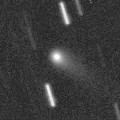
|
Now it is bright as 12.4 mag (Jan. 9, Seiichi Yoshida). It keeps 12 mag for a long time from 2015 autumn to 2016 summer. In the Northern Hemispehre, it keeps observable in good condition for a long time. It keeps unobservable in the Southern Hemisphere.
Date(TT) R.A. (2000) Decl. Delta r Elong. m1 Best Time(A, h)
Jan. 30 20 10.91 66 12.5 2.616 2.704 84 12.1 3:39 (209,-43)
Feb. 6 20 18.02 65 25.5 2.646 2.693 82 12.1 3:49 (210,-40)
|
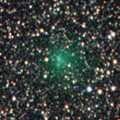
|
Now it is 11.8 mag (Jan. 8, Giuseppe Pappa). It keeps 11-13 mag until February. But it keeps very low.
Date(TT) R.A. (2000) Decl. Delta r Elong. m1 Best Time(A, h)
Jan. 30 23 10.26 -13 36.4 2.335 1.625 34 12.8 20:46 ( 78, 6)
Feb. 6 23 30.08 -11 42.2 2.398 1.660 32 13.1 20:37 ( 79, 5)
|
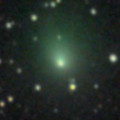
|
It is not observable now. It will appear in the morning sky in June. But the comet will be faint as 16-17 mag.
Date(TT) R.A. (2000) Decl. Delta r Elong. m1 Best Time(A, h)
Jan. 30 22 4.27 -13 54.2 2.734 1.831 19 13.0 20:46 ( 68, -7)
Feb. 6 22 22.10 -12 23.7 2.790 1.866 16 13.2 20:37 ( 69, -8)
|
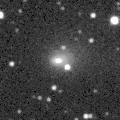
|
Now it is 13.6 mag (Jan. 29, Sandor Szabo). It will brighten up to 11 mag from spring to summer. In the Northern Hemisphere, it keeps observable in good condition while the comet will be brightening. It locates somewhat low in the Southern Hemisphere.
Date(TT) R.A. (2000) Decl. Delta r Elong. m1 Best Time(A, h)
Jan. 30 5 2.45 19 43.3 1.527 2.262 127 13.2 20:46 (174, 35)
Feb. 6 5 1.56 19 57.3 1.559 2.221 119 13.1 20:37 (169, 34)
|
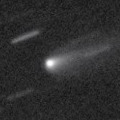
|
Now it is 13.3 mag (Jan. 9, Seiichi Yoshida). It will brighten up to 13 mag from winter to spring. It will be observable in excellent condition in the Southern Hemisphere. But it locates somewhat low in the Northern Hemisphere.
Date(TT) R.A. (2000) Decl. Delta r Elong. m1 Best Time(A, h)
Jan. 30 14 59.44 -16 59.8 2.100 2.191 81 13.6 3:39 (255, 49)
Feb. 6 15 10.09 -17 54.0 2.024 2.195 86 13.6 3:49 (250, 55)
|

|
It brightened up to 3.7 mag and became a naked eye comet in mid January in 2015 (Jan. 13, Marek Biely). Now it is fading. It has already faded down to 15.2 mag (Jan. 16, Yuji Ohshima). In the Northern Hemisphere, it keeps observable for a long time until the comet fades out. It is not observable until March in the Southern Hemisphere.
Date(TT) R.A. (2000) Decl. Delta r Elong. m1 Best Time(A, h)
Jan. 30 18 12.76 20 13.4 5.175 4.660 53 13.6 3:39 (253,-11)
Feb. 6 18 17.10 20 27.8 5.192 4.727 56 13.7 3:49 (249, -5)
|

|
Appearing in the morning sky in the Southern Hemisphere. It will be observable soon also in the Northern Hemisphere.
Date(TT) R.A. (2000) Decl. Delta r Elong. m1 Best Time(A, h)
Jan. 30 19 3.96 -27 2.1 6.842 5.968 25 14.0 3:39 (299, 6)
Feb. 6 19 9.84 -26 51.6 6.788 5.966 31 14.0 3:49 (295, 11)
|
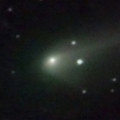
|
It brightened up to 11.1 mag in 2015 autumn (Sept. 21, Seiichi Yoshida). Now it is 15.2 mag (Jan. 18, Thomas Lehmann). It keeps observable in good condition after this, while the comet will be fading gradually.
Date(TT) R.A. (2000) Decl. Delta r Elong. m1 Best Time(A, h)
Jan. 30 12 21.95 8 18.6 1.509 2.243 126 14.4 3:39 (183, 47)
Feb. 6 12 18.58 8 54.2 1.492 2.297 134 14.6 3:18 (180, 46)
|
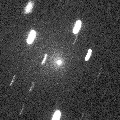
|
It passed near by the earth and brightened up to 12.1 mag from mid December to early January (Dec. 20, Thomas Lehmann). Now it is 13 mag (Jan. 26, Giuseppe Pappa). It is observable in excellent condition in the Northern Hemisphere. However, it will be fading rapidly after this. It is not observable in the Southern Hemisphere.
Date(TT) R.A. (2000) Decl. Delta r Elong. m1 Best Time(A, h)
Jan. 30 3 13.61 56 9.3 1.300 1.864 108 14.5 20:46 (162, -5)
Feb. 6 3 1.96 50 55.4 1.500 1.936 100 14.9 20:37 (156, -3)
|

|
Now it is 14.8 mag (Nov. 22, Catalina Sky Survey). Distant object, but it keeps observable at 14-15 mag for a long time from 2015 to 2016. It becomes unobservable temporarily from January to March in the Southern Hemisphere, or from February to April in the Northern Hemisphere.
Date(TT) R.A. (2000) Decl. Delta r Elong. m1 Best Time(A, h)
Jan. 30 22 22.27 -6 2.7 5.823 4.958 26 14.8 20:46 ( 77, -9)
Feb. 6 22 29.29 -5 38.2 5.858 4.949 20 14.8 20:37 ( 75,-11)
|
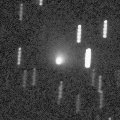
|
It kept brightening even after the perihelion passage, and brightened up to 13.0 mag (Dec. 21, Juan Jose Gonzalez). It keeps observable in excellent condition for a while. But it will be fading after this. It has already faded down to 15.4 mag (Jan. 29, Sandor Szabo).
Date(TT) R.A. (2000) Decl. Delta r Elong. m1 Best Time(A, h)
Jan. 30 5 22.80 20 32.0 0.840 1.668 131 14.8 20:47 (180, 34)
Feb. 6 5 30.94 22 33.2 0.915 1.701 126 15.1 20:37 (177, 32)
|
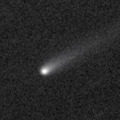
|
It brightened very rapidly in 2015 spring, and reached up to 13.8 mag (May 11, Sandor Szabo). It is bright as 15.5 mag still now (Dec. 20, Jean-Francois Soulier). It keeps 15-16 mag for a while until spring. It is observable in excellent condition in the Southern Hemisphere. But it locates somewhat low in the Northern Hemisphere.
Date(TT) R.A. (2000) Decl. Delta r Elong. m1 Best Time(A, h)
Jan. 30 14 7.38 -26 53.7 3.678 3.814 90 15.5 3:39 (260, 64)
Feb. 6 14 10.80 -27 34.7 3.600 3.836 96 15.5 3:49 (252, 71)
|
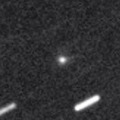
|
Appearing in the morning sky. It will be observable at 14 mag in good condition from spring to summer.
Date(TT) R.A. (2000) Decl. Delta r Elong. m1 Best Time(A, h)
Jan. 30 17 56.27 -18 24.0 3.208 2.540 40 15.6 3:39 (283, 14)
Feb. 6 18 10.31 -18 21.1 3.136 2.524 44 15.5 3:49 (280, 18)
|
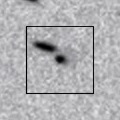
|
Now it is 18.6 mag (Dec. 17, A. Klotz, F. Kugel, C. Rinner). It will be observable at 11 mag in good condition from spring to summer.
Date(TT) R.A. (2000) Decl. Delta r Elong. m1 Best Time(A, h)
Jan. 30 12 26.15 14 12.2 1.542 2.279 127 15.9 3:39 (184, 41)
Feb. 6 12 28.64 14 47.4 1.442 2.239 133 15.5 3:28 (180, 40)
|
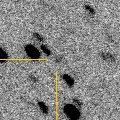
|
Now it is 19.6 mag (Dec. 14, K. Hills). It will brighten very rapidly and reach up to 11 mag in March. In this apparition, it keeps observable in excellent condition both brightening and fading period. In the Northern Hemisphere, it will be unobservable temporarily in mid March.
Date(TT) R.A. (2000) Decl. Delta r Elong. m1 Best Time(A, h)
Jan. 30 6 4.46 -19 36.6 0.290 1.176 125 16.0 21:27 (180, 75)
Feb. 6 5 57.30 -21 45.8 0.254 1.129 118 15.5 20:53 (180, 77)
|
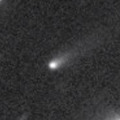
|
Now it is 16.7 mag (Dec. 11, D. Buczynski). It will brighten rapidly after this, and it will be observable at 14-15 mag in good condition from winter to summer.
Date(TT) R.A. (2000) Decl. Delta r Elong. m1 Best Time(A, h)
Jan. 30 13 37.99 -1 33.4 1.975 2.436 105 15.7 3:39 (215, 51)
Feb. 6 13 41.30 -2 38.1 1.879 2.424 111 15.6 3:49 (203, 56)
|
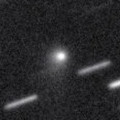
|
Now it is 15.7 mag (Dec. 19, Y. Sugiyama). It keeps 15-16 mag for a long time until 2016. It keeps observable in excellent condition in the Northern Hemisphere. It keeps unobservable in the Southern Hemisphere.
Date(TT) R.A. (2000) Decl. Delta r Elong. m1 Best Time(A, h)
Jan. 30 2 43.71 73 23.5 4.885 5.257 106 15.7 20:46 (169,-22)
Feb. 6 2 42.21 73 2.7 4.959 5.266 102 15.7 20:37 (167,-22)
|
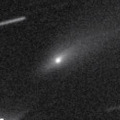
|
Now it is 15.8 mag (Dec. 7, Yuji Ohshima). In the Northern Hemisphere, it keeps observable after this while the comet will be fading. It will be getting higher gradually after this also in the Southern Hemisphere.
Date(TT) R.A. (2000) Decl. Delta r Elong. m1 Best Time(A, h)
Jan. 30 14 21.40 22 59.5 2.407 2.792 102 16.0 3:39 (213, 25)
Feb. 6 14 23.31 23 52.9 2.375 2.839 108 16.1 3:49 (204, 27)
|
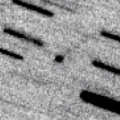
|
First return of an object discovered as an asteroid 2007 VA85 in 2007. Faint tail was observed on Jan. 8 by Hidetaka Sato. Now it is 17.2 mag (Jan. 10, E. Bryssinck). It will approach to the earth down to 0.5 a.u., will brighten up to 15-16 mag, and will be observable in excellent condition.
Date(TT) R.A. (2000) Decl. Delta r Elong. m1 Best Time(A, h)
Jan. 30 9 22.90 -47 51.7 0.700 1.420 113 16.6 0:54 ( 0, 77)
Feb. 6 7 51.30 -40 56.6 0.574 1.366 119 16.0 22:39 ( 0, 85)
|
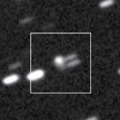
|
Now it is 16.4 mag (Jan. 15, Thomas Lehmann). It is expected to brighten up to 7 mag in 2017 summer. In the Northern Hemisphere, it keeps observable in good condition until the highlight while the comet will be brightening. In the Southern Hemisphere, it is not observable until early 2017.
Date(TT) R.A. (2000) Decl. Delta r Elong. m1 Best Time(A, h)
Jan. 30 7 18.31 64 10.3 5.038 5.737 131 16.1 22:42 (180, -9)
Feb. 6 7 9.78 64 11.9 5.026 5.677 127 16.0 22:06 (180, -9)
|
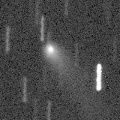
|
Now it is 15.3 mag (Dec. 13, D. Buczynski). It kept 15 mag for a long time from 2014 to 2015. But it will be fading slowly after this. It is observable in good condition in the Northern Hemisphere. It will not be observable after this in the Southern Hemisphere.
Date(TT) R.A. (2000) Decl. Delta r Elong. m1 Best Time(A, h)
Jan. 30 0 38.96 46 5.8 4.790 4.765 82 16.2 20:46 (138,-13)
Feb. 6 0 43.13 46 21.8 4.909 4.799 77 16.3 20:37 (137,-15)
|
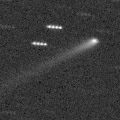
|
Now it is 15.4 mag (Dec. 8, Yasukazu Ikari). It will be fading slowly after this. It will be unobservable soon in the Southern Hemisphere. It will be unobservable in early March also in the Northern Hemisphere. But it will be observable again at 17 mag in good condition in autumn.
Date(TT) R.A. (2000) Decl. Delta r Elong. m1 Best Time(A, h)
Jan. 30 0 2.06 17 5.1 4.774 4.356 59 16.3 20:46 (110, -2)
Feb. 6 0 2.46 17 37.4 4.893 4.373 53 16.3 20:37 (108, -6)
|
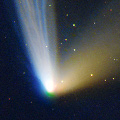
|
It approached to the sun down to 0.3 a.u. on July 6, 2015, and brighted up to 3.9 mag (July 6, Thomas Lehmann). Now it is fading. It has already faded down to 12.9 mag in October (Oct. 3, Chris Wyatt). No observations have been reported since November. In the Southern Hemisphere, it keeps observable until the comet fades out. It will not be observable after this in the Northern Hemisphere.
Date(TT) R.A. (2000) Decl. Delta r Elong. m1 Best Time(A, h)
Jan. 30 19 17.17 -57 45.3 4.221 3.567 43 16.3 3:39 (327, 21)
Feb. 6 19 30.16 -58 4.1 4.261 3.652 46 16.4 3:49 (325, 24)
|

|
It brightened up to 11-12 mag in 2012. It has already faded down to 17.2 mag (Dec. 19, Yuji Ohshima). It is observable at 16-17 mag in good condition from winter to spring.
Date(TT) R.A. (2000) Decl. Delta r Elong. m1 Best Time(A, h)
Jan. 30 11 2.37 -6 51.1 10.109 10.865 138 16.3 2:29 (180, 62)
Feb. 6 10 59.35 -6 39.4 10.073 10.902 145 16.3 1:59 (180, 62)
|
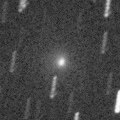
|
First return of a periodic comet discovered in 2003. Now it is 15.1 mag (Dec. 17, Space Surveillance Telescope, Atom Site). It will be fading after this, and will be fainter than 18 mag in March. It is observable in excellent condition in the Northern Hemisphere. It locates low in the Southern Hemisphere.
Date(TT) R.A. (2000) Decl. Delta r Elong. m1 Best Time(A, h)
Jan. 30 4 49.65 31 33.1 1.006 1.767 125 16.3 20:46 (173, 23)
Feb. 6 4 58.25 33 23.0 1.085 1.794 119 16.6 20:37 (171, 21)
|
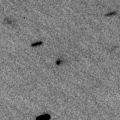
|
Now it is 16.9 mag (Nov. 17, J. Nicolas, C. Rinner, F. Kugel, A. Klotz). It will brighten up to 14 mag in 2017. In 2016, it keeps observable at 16 mag in good condition from winter to spring.
Date(TT) R.A. (2000) Decl. Delta r Elong. m1 Best Time(A, h)
Jan. 30 12 7.75 11 12.2 3.238 3.956 131 16.5 3:34 (180, 44)
Feb. 6 12 6.33 11 36.9 3.148 3.940 138 16.4 3:05 (180, 43)
|

|
Now it is 16.9 mag (Nov. 15, J. Bel). It will brighten up to 14 mag in summer. But it is not observable at the highlight. It keeps observable until March while the comet will be brightening gradually up to 15-16 mag.
Date(TT) R.A. (2000) Decl. Delta r Elong. m1 Best Time(A, h)
Jan. 30 1 11.04 -0 21.6 2.448 2.256 67 16.5 20:46 (106, 22)
Feb. 6 1 21.45 0 50.4 2.500 2.231 62 16.5 20:37 (106, 20)
|
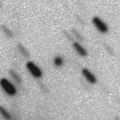
|
Now it is bright as 16.0 mag (Jan. 29, Sandor Szabo). It keeps observable in good condition for a while.
Date(TT) R.A. (2000) Decl. Delta r Elong. m1 Best Time(A, h)
Jan. 30 5 34.04 14 9.9 2.720 3.473 133 16.6 20:58 (180, 41)
Feb. 6 5 33.70 13 34.4 2.808 3.486 126 16.7 20:37 (178, 41)
|
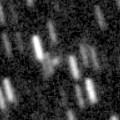
|
Now it is 17.0 mag (Nov. 3, A. Maury, J.-F. Soulier, J.-G. Bosch, T. Noel). It keeps 16.5 mag for a long time in 2016, and it will be observable in excellent condition in the Southern Hemisphere. It is hardly observable in the Northern Hemisphere.
Date(TT) R.A. (2000) Decl. Delta r Elong. m1 Best Time(A, h)
Jan. 30 4 45.64 -61 29.7 3.394 3.491 87 16.6 20:46 ( 10, 63)
Feb. 6 4 25.36 -59 43.3 3.423 3.474 84 16.6 20:37 ( 21, 62)
|
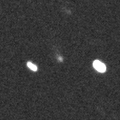
|
Now it is 16.9 mag (Dec. 13, K. Hills). It keeps 16-17 mag for a long time until 2016 autumn. In the Southern Hemisphere, it keeps observable in good condition for a long time. In the Northern Hemisphere, it is observable only until March.
Date(TT) R.A. (2000) Decl. Delta r Elong. m1 Best Time(A, h)
Jan. 30 3 47.66 -27 38.7 2.514 2.771 94 16.6 20:46 (104, 69)
Feb. 6 3 43.25 -28 0.2 2.571 2.730 88 16.6 20:37 ( 97, 64)
|
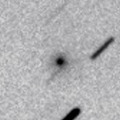
|
Now it is 16.8 mag (Dec. 18, Space Surveillance Telescope, Atom Site). It is observable at 16.5 mag in excellent condition from December to February. It locates somewhat low in the Southern Hemisphere.
Date(TT) R.A. (2000) Decl. Delta r Elong. m1 Best Time(A, h)
Jan. 30 8 21.68 23 20.2 0.994 1.974 171 16.6 23:45 (180, 32)
Feb. 6 8 18.02 24 6.4 1.021 1.988 164 16.7 23:14 (180, 31)
|
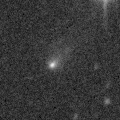
|
Now it is 16.5 mag (Dec. 20, Michael Jager). It must have been observable at 16-17 mag in good condition from summer to autumn in the Northern Hemisphere, but it was not discovered. It will be fading after this, and will be fainter than 18 mag in April.
Date(TT) R.A. (2000) Decl. Delta r Elong. m1 Best Time(A, h)
Jan. 30 12 30.36 34 15.9 1.745 2.476 127 16.6 3:39 (184, 21)
Feb. 6 12 18.17 33 46.3 1.719 2.517 135 16.7 3:18 (180, 21)
|
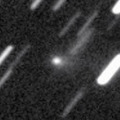
|
Now it is 17.0 mag (Dec. 16, Purple Mountain Observatory). It is observable at 17 mag in good condition in winter.
Date(TT) R.A. (2000) Decl. Delta r Elong. m1 Best Time(A, h)
Jan. 30 7 59.67 23 33.8 1.379 2.351 167 16.9 23:23 (180, 31)
Feb. 6 7 54.96 24 56.7 1.404 2.351 159 16.9 22:51 (180, 30)
|
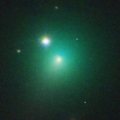
|
It brightened up to 8.8 mag in 2015 spring (Apr. 3, Marco Goiato). Now it is fading. It has already faded down to 15.9 mag (Dec. 15, S. Shurpakov). It keeps observable until March when the comet becomes fainter than 18 mag.
Date(TT) R.A. (2000) Decl. Delta r Elong. m1 Best Time(A, h)
Jan. 30 2 8.22 12 41.1 2.905 2.984 84 17.0 20:46 (127, 24)
Feb. 6 2 14.32 13 18.7 3.044 3.023 79 17.2 20:37 (125, 21)
|
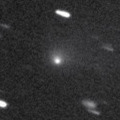
|
It brightened up to 14.5 mag in autumn (Nov. 11, Sandor Szabo). Now it is fading. It has already faded down to 16.7 mag (Dec. 14, L. Elenin). It will be fainter than 18 mag in March.
Date(TT) R.A. (2000) Decl. Delta r Elong. m1 Best Time(A, h)
Jan. 30 2 49.60 9 9.8 2.021 2.301 93 17.0 20:46 (134, 33)
Feb. 6 2 58.65 10 6.2 2.123 2.322 88 17.2 20:37 (132, 31)
|
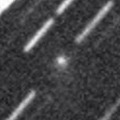
|
Now it is 17.5 mag (Dec. 17, Space Surveillance Telescope, Atom Site). It keeps observable at 17.5 mag in good condition from winter to spring in the Northern Hemispehre. It is observable only until mid February in the Southern Hemisphere.
Date(TT) R.A. (2000) Decl. Delta r Elong. m1 Best Time(A, h)
Jan. 30 7 13.88 33 7.9 1.626 2.549 154 17.1 22:36 (180, 22)
Feb. 6 6 56.65 36 43.1 1.654 2.512 142 17.1 21:52 (180, 18)
|

|
Now it is 18.3 mag (Nov. 15, Hidetaka Sato). It keeps observable at 17 mag in good condition from winter to spring.
Date(TT) R.A. (2000) Decl. Delta r Elong. m1 Best Time(A, h)
Jan. 30 14 46.16 2 18.4 2.292 2.509 90 17.3 3:39 (232, 38)
Feb. 6 14 53.49 2 10.5 2.215 2.515 95 17.2 3:49 (224, 43)
|

|
Now it is 17.4 mag (Dec. 11, Purple Mountain Observatory). It will brighten up to 13 mag in summer. But it is not observable around the highlight. In the Southern Hemisphere, it is observable until February when it brightens up to 17 mag. In the Northern Hemisphere, it is observable until April when it brightens up to 16 mag. Sandor Szabo reported it is bright as 16.0 mag visually on Jan. 29.
Date(TT) R.A. (2000) Decl. Delta r Elong. m1 Best Time(A, h)
Jan. 30 2 1.27 10 58.1 3.061 3.095 82 17.3 20:46 (125, 24)
Feb. 6 2 5.79 11 9.9 3.093 3.024 76 17.3 20:37 (122, 21)
|

|
It has not been observed yet in this apparition. It tends to be brightest after the perihelion passage. It is observable at 17 mag in excellent condition until March in the Northern Hemisphere. It locates low in the Southern Hemisphere.
Date(TT) R.A. (2000) Decl. Delta r Elong. m1 Best Time(A, h)
Jan. 30 5 1.36 41 47.6 0.949 1.728 126 17.3 20:46 (176, 13)
Feb. 6 5 9.24 40 37.9 0.979 1.717 121 17.3 20:37 (174, 14)
|
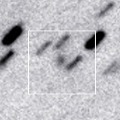
|
Now it is 16.9 mag (Dec. 19, Y. Sugiyama). It keeps 17.5 mag for a long time from 2016 to 2019. It keeps locating near by the equator.
Date(TT) R.A. (2000) Decl. Delta r Elong. m1 Best Time(A, h)
Jan. 30 8 4.51 -0 9.8 9.173 10.100 159 17.4 23:28 (180, 55)
Feb. 6 8 2.88 0 5.5 9.178 10.088 156 17.4 22:58 (180, 55)
|
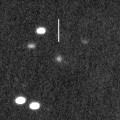
|
Now it is 17.2 mag (Nov. 18, Catalina Sky Survey). Now it is near the aphelion. It is observable at 17 mag in good condition from autumn to winter.
Date(TT) R.A. (2000) Decl. Delta r Elong. m1 Best Time(A, h)
Jan. 30 3 8.90 15 47.4 3.908 4.191 99 17.4 20:46 (142, 30)
Feb. 6 3 11.01 16 4.7 4.007 4.182 93 17.4 20:37 (139, 28)
|
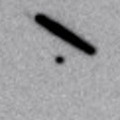
|
Now it is 17.1 mag (Dec. 13, D. Buczynski). It is observable in good condition in the Northern Hemisphere. It is not observable in the Southern Hemisphere.
Date(TT) R.A. (2000) Decl. Delta r Elong. m1 Best Time(A, h)
Jan. 30 11 9.80 52 47.5 1.605 2.408 135 17.5 2:37 (180, 2)
Feb. 6 10 57.33 53 28.0 1.638 2.456 137 17.6 1:57 (180, 2)
|
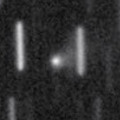
|
Brightening very rapidly, and it keeps brightening even after the perihelion passage. It was very bright as 15.9 mag in December (Dec. 16, Catalina Sky Survey). Probably it is fading now. It keeps observable in excellent condition for a while.
Date(TT) R.A. (2000) Decl. Delta r Elong. m1 Best Time(A, h)
Jan. 30 5 46.46 -12 7.2 1.415 2.150 126 17.5 21:10 (180, 67)
Feb. 6 5 47.86 -10 45.4 1.492 2.183 122 17.8 20:44 (180, 66)
|
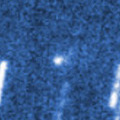
|
Now it is 17.8 mag (Dec. 18, Hidetaka Sato). It keeps observable at 17.5 mag in good condition until April.
Date(TT) R.A. (2000) Decl. Delta r Elong. m1 Best Time(A, h)
Jan. 30 8 50.25 2 25.0 1.799 2.761 164 17.7 0:18 (180, 53)
Feb. 6 8 42.17 5 59.7 1.761 2.731 167 17.6 23:37 (180, 49)
|
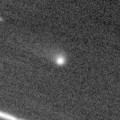
|
It brightened up to 16 mag in early 2015. Now it is 18.1 mag (Dec. 12, ATLAS-HKO, Haleakala). It is observable at 18 mag from winter to spring.
Date(TT) R.A. (2000) Decl. Delta r Elong. m1 Best Time(A, h)
Jan. 30 9 55.66 -24 44.9 5.300 6.028 134 17.6 1:23 (180, 80)
Feb. 6 9 47.20 -24 29.6 5.274 6.052 138 17.6 0:47 (180, 80)
|
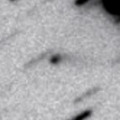
|
Now it is 17.6 mag (Dec. 17, A. Hidas). It keeps 17-18 mag for a long time until 2017 spring.
Date(TT) R.A. (2000) Decl. Delta r Elong. m1 Best Time(A, h)
Jan. 30 6 41.43 -23 28.0 3.337 4.024 128 17.7 22:04 (180, 78)
Feb. 6 6 38.37 -21 48.0 3.339 4.000 126 17.6 21:34 (180, 77)
|
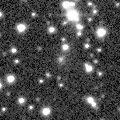
|
It will pass the perihelion in 2019. However, it has not been brightening since the discovery in 2010. Now it is 17.6 mag (Dec. 3, D. Buczynski). It keeps observable in excellent condition in the Northern Hemisphere, although it becomes low temporarily in May. It is not observable in the Southern Hemisphere.
Date(TT) R.A. (2000) Decl. Delta r Elong. m1 Best Time(A, h)
Jan. 30 3 8.25 47 4.0 10.338 10.661 106 17.7 20:46 (158, 3)
Feb. 6 3 8.20 46 57.5 10.416 10.637 100 17.7 20:37 (155, 1)
|
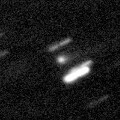
|
It brightened up to 15.2 mag in early 2015 (Feb. 24, Toshiyuki Takahashi). Now it is 17.5 mag (Dec. 6, Catalina Sky Survey). It will be fainter than 18 mag in April.
Date(TT) R.A. (2000) Decl. Delta r Elong. m1 Best Time(A, h)
Jan. 30 11 41.67 -6 19.3 4.045 4.745 130 17.7 3:08 (180, 61)
Feb. 6 11 40.04 -6 16.9 3.986 4.763 137 17.7 2:39 (180, 61)
|
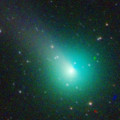
|
It brightened up to 6.0 mag in mid May (May 14, Chris Wyatt). Now it is fading. It has already faded down to 16.4 mag (Dec. 7, Yasukazu Ikari). In the Northern Hemisphere, it keeps observable in good condition after this while the comet will be fading. It locates somewhat low in the Southern Hemisphere.
Date(TT) R.A. (2000) Decl. Delta r Elong. m1 Best Time(A, h)
Jan. 30 5 1.50 37 47.7 3.077 3.756 127 17.8 20:46 (176, 17)
Feb. 6 4 53.66 37 25.7 3.258 3.834 118 18.1 20:37 (170, 17)
|

|
It has not been observed in this apparition yet. It will brighten up to 16 mag from March to June. It is observable in excellent condition in the Southern Hemisphere. It locates somewhat low in the Northern Hemisphere.
Date(TT) R.A. (2000) Decl. Delta r Elong. m1 Best Time(A, h)
Jan. 30 15 2.75 -6 3.7 1.919 2.069 84 18.0 3:39 (244, 41)
Feb. 6 15 12.53 -7 34.7 1.829 2.057 88 17.8 3:49 (238, 47)
|
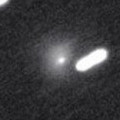
|
Very far object. Outburst occured on Feb. 20, 2015, and it brightened up to 15 mag. But it is faint as 18 mag now. It is observable in excellent condition in the Southern Hemisphere. It locates somewhat low in the Northern Hemisphere.
Date(TT) R.A. (2000) Decl. Delta r Elong. m1 Best Time(A, h)
Jan. 30 13 33.01 -26 0.7 8.963 9.149 97 17.9 3:39 (248, 71)
Feb. 6 13 33.39 -26 10.0 8.853 9.150 104 17.8 3:49 (230, 77)
|

|
Now it is 17.7 mag (Nov. 30, Hidetaka Sato). It was expected to brighten up to 14 mag from winter to summer. But it is much fainter actually. It will be observable in excellent condition in the Southern Hemisphere. It locates low in the Northern Hemisphere.
Date(TT) R.A. (2000) Decl. Delta r Elong. m1 Best Time(A, h)
Jan. 30 15 16.13 -20 5.8 2.247 2.247 77 17.9 3:39 (262, 47)
Feb. 6 15 28.14 -21 41.0 2.180 2.253 81 17.9 3:49 (260, 53)
|
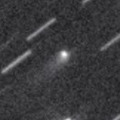
|
It keeps 17-18 mag for a long time since 2013. In the Northern Hemisphere, it is observable at 18 mag in good condition also in this winter. It is not observable in the Southern Hemisphere.
Date(TT) R.A. (2000) Decl. Delta r Elong. m1 Best Time(A, h)
Jan. 30 14 21.16 58 34.4 6.995 7.368 108 17.9 3:39 (196, -7)
Feb. 6 14 16.59 59 32.1 6.978 7.390 111 17.9 3:49 (191, -6)
|
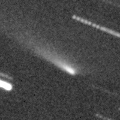
|
It brightened up to 12.0-12.5 mag from early December to early January (Dec. 8, Michael Jager). Now it must be fading very rapidly.
Date(TT) R.A. (2000) Decl. Delta r Elong. m1 Best Time(A, h)
Jan. 30 0 47.20 5 31.5 1.380 1.292 63 18.0 20:46 (108, 14)
Feb. 6 1 14.52 7 48.1 1.505 1.388 63 18.7 20:37 (111, 14)
|
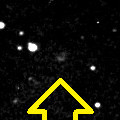
|
Now it is 19.0 mag (Jan. 10, B. Lutkenhoner). The brightness differs in every apparition. It was not observed in the last apparition. In this apparition, it was expected to be observable at 14-15 mag from winter to spring. But it will be 17 mag at best. It locates extremely low in the Southern Hemisphere.
Date(TT) R.A. (2000) Decl. Delta r Elong. m1 Best Time(A, h)
Jan. 30 23 33.97 1 21.2 1.882 1.381 45 18.5 20:46 ( 93, 2)
Feb. 6 23 54.25 2 48.6 1.871 1.340 43 18.3 20:37 ( 95, 1)
|
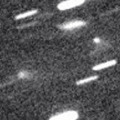
|
First return of a periodic comet which brightened up to 8 mag in major outburst in 2010. It will be observable in excellent condition from winter to spring. However, now it is so faint; the fragment A is 17.9 mag and the fragment B is 18.2 mag (Jan. 15, Toshiyuki Takahashi). It will be 18-19 mag at best in this apparition. Pieter-Jan Dekelver reported the fragments C and D are also visible at 21-22 mag.
Date(TT) R.A. (2000) Decl. Delta r Elong. m1 Best Time(A, h)
Jan. 30 9 2.60 36 48.3 0.674 1.636 160 18.8 0:30 (180, 18)
Feb. 6 8 57.35 36 19.3 0.659 1.619 159 18.7 23:53 (180, 19)
|
|
![]()
 C/2015 TQ209 ( LINEAR )
C/2015 TQ209 ( LINEAR ) 194P/LINEAR
194P/LINEAR C/2014 B1 ( Schwartz )
C/2014 B1 ( Schwartz ) 74P/Smirnova-Chernykh
74P/Smirnova-Chernykh 162P/Siding Spring
162P/Siding Spring P/2015 Q1 ( Scotti )
P/2015 Q1 ( Scotti ) C/2015 Y1 ( LINEAR )
C/2015 Y1 ( LINEAR ) C/2013 G9 ( Tenagra )
C/2013 G9 ( Tenagra ) C/2015 X7 ( ATLAS )
C/2015 X7 ( ATLAS ) C/2010 U3 ( Boattini )
C/2010 U3 ( Boattini ) 269P/2012 R2 ( Jedicke )
269P/2012 R2 ( Jedicke ) C/2015 G2 ( MASTER )
C/2015 G2 ( MASTER ) 100P/Hartley 1
100P/Hartley 1 C/2013 C2 ( Tenagra )
C/2013 C2 ( Tenagra ) C/2014 Y1 ( PanSTARRS )
C/2014 Y1 ( PanSTARRS ) C/2012 K8 ( Lemmon )
C/2012 K8 ( Lemmon ) 249P/LINEAR
249P/LINEAR 104P/Kowal 2
104P/Kowal 2 331P/2015 Y2 ( Ikeya-Murakami )
331P/2015 Y2 ( Ikeya-Murakami )![]()























































